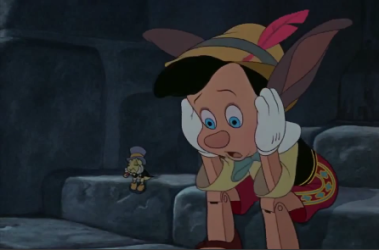 The scene then transitions to Pinocchio and Jiminy Cricket arising from the water and going back onto the surface. When they finally arrive home, they realize that Gepetto is missing, and if you remember, the last time we saw Gepetto was when he was in the rain searching for Pinocchio. I think the idea the movie is trying to portray here is that Pinocchio is a changed person because of these experiences, and when he tries to fit into who he was before by going back home, he can’t do it; he can’t fit exactly into what he was before.
The scene then transitions to Pinocchio and Jiminy Cricket arising from the water and going back onto the surface. When they finally arrive home, they realize that Gepetto is missing, and if you remember, the last time we saw Gepetto was when he was in the rain searching for Pinocchio. I think the idea the movie is trying to portray here is that Pinocchio is a changed person because of these experiences, and when he tries to fit into who he was before by going back home, he can’t do it; he can’t fit exactly into what he was before.
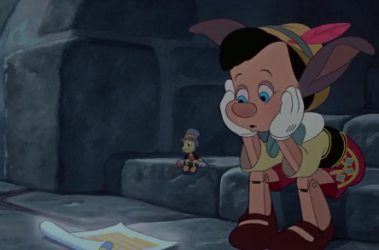 There are two problems that are presented to the hero and his conscience: where is Gepetto, and what do they do about not being able to go home anymore? Well, a heavenly dove arrives and drops a glowing parcel for Pinocchio and Jiminy Cricket that tells them that Gepetto was swallowed by a whale named Monstro. What is going on here is that when you orient your vision or goal, different things appear to you as a result. This is a consequence of the fact that we can only handle so much information at a time and that when you focus on something intensely, your mind will see only things that are important to getting to the point in which you are aiming at. Literally, things that aren’t relevant to you: you don’t see them, and this is a psychological phenomenon that has been tested many times.
There are two problems that are presented to the hero and his conscience: where is Gepetto, and what do they do about not being able to go home anymore? Well, a heavenly dove arrives and drops a glowing parcel for Pinocchio and Jiminy Cricket that tells them that Gepetto was swallowed by a whale named Monstro. What is going on here is that when you orient your vision or goal, different things appear to you as a result. This is a consequence of the fact that we can only handle so much information at a time and that when you focus on something intensely, your mind will see only things that are important to getting to the point in which you are aiming at. Literally, things that aren’t relevant to you: you don’t see them, and this is a psychological phenomenon that has been tested many times.
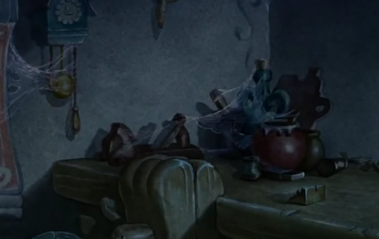 What I think about all of this in particular is a question Pinocchio perhaps is subconsciously thinking that brings forth the heavenly dove. It’s clear that Pinocchio had a moral structure that was orienting him properly in context with the world, and as far as it was embodied in Gepetto, that is now gone: so what do I do about that? Is there any way to find that mode of being again? And that is a consequence of him having to fully dive into the realm of chaos to remove himself from the pathological state; however, as we can see, Pinocchio still has the donkey tail and ears, so in a way, Pinocchio is still influenced by the pathology, the waters of chaos didn’t fully wash that away. So another question arises: what does Pinocchio have to do to free himself of the pathology if diving into the surface of chaos didn’t fully get rid of it?
What I think about all of this in particular is a question Pinocchio perhaps is subconsciously thinking that brings forth the heavenly dove. It’s clear that Pinocchio had a moral structure that was orienting him properly in context with the world, and as far as it was embodied in Gepetto, that is now gone: so what do I do about that? Is there any way to find that mode of being again? And that is a consequence of him having to fully dive into the realm of chaos to remove himself from the pathological state; however, as we can see, Pinocchio still has the donkey tail and ears, so in a way, Pinocchio is still influenced by the pathology, the waters of chaos didn’t fully wash that away. So another question arises: what does Pinocchio have to do to free himself of the pathology if diving into the surface of chaos didn’t fully get rid of it?
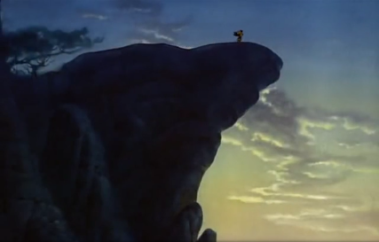 Well, regardless of how these questions are answered and if Pinocchio can truly get back what he had before, Pinocchio is still determined to rescue his father from the belly of the whale. And what that means up until now is that, if you are in a chaotic state and order [structure] itself falls apart, there is the possibility is that this order can come back together – including what you just learned – in a new and improved state. A way of visualizing this is to envision the dead father at the bottom of the sea of chaos; there is something down there [the father] that is capable on reemerging that incorporates the previous state but takes it father. And the only way to do that is to rescue your dead father from the belly of the whale itself, so that you can become reincarnated with the new ideas to update the old structure, and you do this so that you can live in Tao or to live in meaning, and that is why there is a small white circle inside of the black paisley and vice-versa.
Well, regardless of how these questions are answered and if Pinocchio can truly get back what he had before, Pinocchio is still determined to rescue his father from the belly of the whale. And what that means up until now is that, if you are in a chaotic state and order [structure] itself falls apart, there is the possibility is that this order can come back together – including what you just learned – in a new and improved state. A way of visualizing this is to envision the dead father at the bottom of the sea of chaos; there is something down there [the father] that is capable on reemerging that incorporates the previous state but takes it father. And the only way to do that is to rescue your dead father from the belly of the whale itself, so that you can become reincarnated with the new ideas to update the old structure, and you do this so that you can live in Tao or to live in meaning, and that is why there is a small white circle inside of the black paisley and vice-versa.
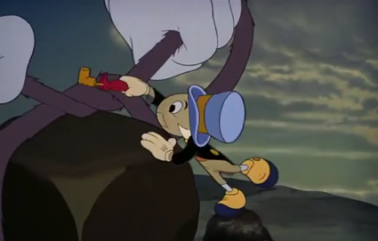 Jiminy Cricket is quite scared about this, and he continuously gives Pinocchio insight about the trouble and hardships he will face by doing this, but Pinocchio is so determined that at one point, Jiminy Cricket becomes paradoxical in his thinking. On the one hand, Jiminy Cricket is pulling Pinocchio back, telling him that this is extremely dangerous, but at the same time, Jiminy Cricket helps Pinocchio in his quest by tying the rock to his tail. The contradiction is that although Jiminy Cricket seemingly doesn’t want him to go; he is helping him both by tying the knot and by spurring his curiosity to begin with. However, I think it is only a contradiction in word, because I believe that deeper than that, Jiminy Cricket knows that it is not only necessary for this to happen, but that Pinocchio needs to be very prepared to accomplish this; therefore, Jiminy Cricket actually goes with him on this quest, which is pretty much a first.
Jiminy Cricket is quite scared about this, and he continuously gives Pinocchio insight about the trouble and hardships he will face by doing this, but Pinocchio is so determined that at one point, Jiminy Cricket becomes paradoxical in his thinking. On the one hand, Jiminy Cricket is pulling Pinocchio back, telling him that this is extremely dangerous, but at the same time, Jiminy Cricket helps Pinocchio in his quest by tying the rock to his tail. The contradiction is that although Jiminy Cricket seemingly doesn’t want him to go; he is helping him both by tying the knot and by spurring his curiosity to begin with. However, I think it is only a contradiction in word, because I believe that deeper than that, Jiminy Cricket knows that it is not only necessary for this to happen, but that Pinocchio needs to be very prepared to accomplish this; therefore, Jiminy Cricket actually goes with him on this quest, which is pretty much a first.
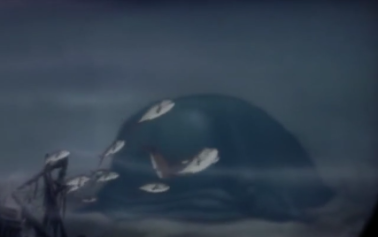 Well, as Pinocchio dives deeper and deeper into the unknown, and when he reaches the very bottom of chaos, we are presented with what Monstro looks like, and what is inside of Monstro: Gepetto’s and his ship. And I think an idea presented to us right here is that there’s an indicating that the father cannot get out of the whale without the son. Gepetto cannot pull himself out of the chaos, he needs his son to do that. The son represents the new ideas, and Gepetto represents the old structure. Although the structure itself was good to begin with, it is decayed to a point where it is no longer beneficial [Gepetto doesn’t know how to get out, and he is starving], and the state must be rejuvenated through the individual.
Well, as Pinocchio dives deeper and deeper into the unknown, and when he reaches the very bottom of chaos, we are presented with what Monstro looks like, and what is inside of Monstro: Gepetto’s and his ship. And I think an idea presented to us right here is that there’s an indicating that the father cannot get out of the whale without the son. Gepetto cannot pull himself out of the chaos, he needs his son to do that. The son represents the new ideas, and Gepetto represents the old structure. Although the structure itself was good to begin with, it is decayed to a point where it is no longer beneficial [Gepetto doesn’t know how to get out, and he is starving], and the state must be rejuvenated through the individual.
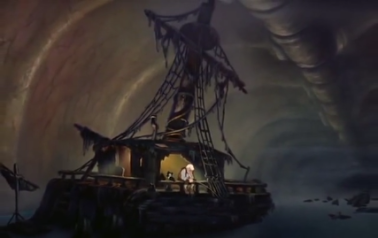 Therefore, the point the movie is trying to make is that if you keep trying to do things the same old way – even though it was beneficial at first, it will not be beneficial forever. Another way of thinking about this is to parallel it with the idea of the United States Constitution. It’s a dead structure composed of ideas from dead people: so what do you do with that? It has to be updated by individuals so that it can respond flexibly and positively in the future; however, at the same time, you can’t just destroy the entire structure and hope for the outcome to be beneficial. You have to incorporate old and new ideas to create the new being, structure, individual, etc.
Therefore, the point the movie is trying to make is that if you keep trying to do things the same old way – even though it was beneficial at first, it will not be beneficial forever. Another way of thinking about this is to parallel it with the idea of the United States Constitution. It’s a dead structure composed of ideas from dead people: so what do you do with that? It has to be updated by individuals so that it can respond flexibly and positively in the future; however, at the same time, you can’t just destroy the entire structure and hope for the outcome to be beneficial. You have to incorporate old and new ideas to create the new being, structure, individual, etc.
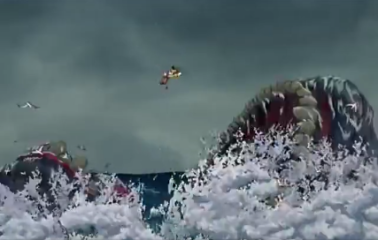 The next event that happens is that Monstro wakes up, and he begins eating quite a lot of fish – including Pinocchio and Jiminy Cricket who get swallowed up by the whale as well. And if you notice, when Pinocchio finally ends up seeing Monstro, he’s paralyzed with fear; it’s as if he saw the Medusa in a sense. And that is common mythological theme: when the hero first encounters the monster that he must face, he is paralyzed with fear and runs away, because the monster was much worse than he could have ever imagined.
The next event that happens is that Monstro wakes up, and he begins eating quite a lot of fish – including Pinocchio and Jiminy Cricket who get swallowed up by the whale as well. And if you notice, when Pinocchio finally ends up seeing Monstro, he’s paralyzed with fear; it’s as if he saw the Medusa in a sense. And that is common mythological theme: when the hero first encounters the monster that he must face, he is paralyzed with fear and runs away, because the monster was much worse than he could have ever imagined.
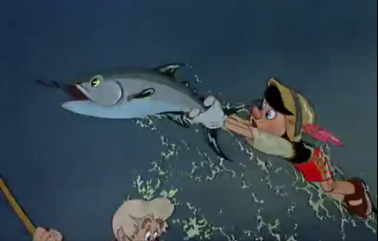 Regardless, Gepetto is having a merry time catching tuna, but he also ends up catching Pinocchio as well, and because he’s so focused on catching fish; he fails to notice that he caught Pinocchio, and he ends up throwing him with the rest of the fish. This is another hint that the movie gives us that Gepetto is an old structure that needs to be updated, and there are a few other hints afterwards of this too. But we can see that now because although Gepetto is doing great at catching fish to survive, he is focused entirely on the wrong problem, or he is perhaps not focused on the larger problem. The major question Gepetto should be solving is: how should I get out of this whale? A nested problem within that he is also starving, so he needs food. So the idea here is that again, Gepetto needs the son not only because he’s an old structure, but also because he is completely oriented at the wrong thing.
Regardless, Gepetto is having a merry time catching tuna, but he also ends up catching Pinocchio as well, and because he’s so focused on catching fish; he fails to notice that he caught Pinocchio, and he ends up throwing him with the rest of the fish. This is another hint that the movie gives us that Gepetto is an old structure that needs to be updated, and there are a few other hints afterwards of this too. But we can see that now because although Gepetto is doing great at catching fish to survive, he is focused entirely on the wrong problem, or he is perhaps not focused on the larger problem. The major question Gepetto should be solving is: how should I get out of this whale? A nested problem within that he is also starving, so he needs food. So the idea here is that again, Gepetto needs the son not only because he’s an old structure, but also because he is completely oriented at the wrong thing.
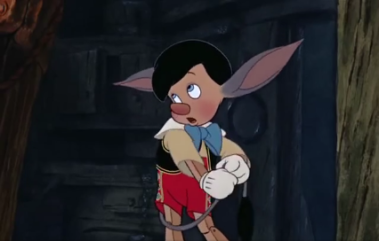 Finally, Gepetto realizes that he caught Pinocchio, and he runs over the fish box to go grab Pinocchio, but instead he ends up hugging a fish, which is another indication that Gepetto’s mind isn’t exactly in the right frame of reference. Regardless, Gepetto eventually realizes and hugs Pinocchio, celebrating them reuniting. However, this is when Gepetto learns about Pinocchio’s donkey ears and tail, so the father realizes that his son is both damaged and degenerated from when he last saw Pinocchio. And a sense, this is a good thing, because Pinocchio is finally being honest about what has happened to him; so in this regard, he has improved from telling lies. And if Pinocchio was unwilling to admit his insufficiencies, he would have never gone to save his father in the first place. It’s a combination of humility on Pinocchio’s part, and an understanding that Pinocchio hasn’t reached the potential of what he could become – a real, “good boy.” Regardless, Gepetto concludes that it’s better to have a jackass son than no son at all, and they hug it out.
Finally, Gepetto realizes that he caught Pinocchio, and he runs over the fish box to go grab Pinocchio, but instead he ends up hugging a fish, which is another indication that Gepetto’s mind isn’t exactly in the right frame of reference. Regardless, Gepetto eventually realizes and hugs Pinocchio, celebrating them reuniting. However, this is when Gepetto learns about Pinocchio’s donkey ears and tail, so the father realizes that his son is both damaged and degenerated from when he last saw Pinocchio. And a sense, this is a good thing, because Pinocchio is finally being honest about what has happened to him; so in this regard, he has improved from telling lies. And if Pinocchio was unwilling to admit his insufficiencies, he would have never gone to save his father in the first place. It’s a combination of humility on Pinocchio’s part, and an understanding that Pinocchio hasn’t reached the potential of what he could become – a real, “good boy.” Regardless, Gepetto concludes that it’s better to have a jackass son than no son at all, and they hug it out.
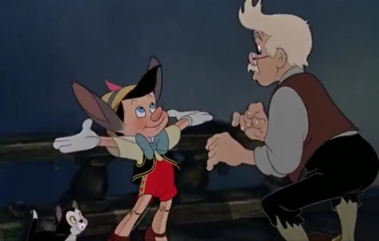 Now that Gepetto and Pinocchio have reunited, you will notice that Pinocchio immediately sets his focus orientation on the real problem in front of them, which is how to get out of the whale. However, a problem then presents itself that Gepetto has built a raft, yet he is unable to use it. And because of this, Gepetto would much rather focus on the fish for now than getting out of the whale; and this is another way of hammering home the fact that Gepetto is not oriented correctly. However, at the same time, Gepetto is still useful because the raft is what saves them from death later on, so it is the combination of the new and old that gives rise to something greater.
Now that Gepetto and Pinocchio have reunited, you will notice that Pinocchio immediately sets his focus orientation on the real problem in front of them, which is how to get out of the whale. However, a problem then presents itself that Gepetto has built a raft, yet he is unable to use it. And because of this, Gepetto would much rather focus on the fish for now than getting out of the whale; and this is another way of hammering home the fact that Gepetto is not oriented correctly. However, at the same time, Gepetto is still useful because the raft is what saves them from death later on, so it is the combination of the new and old that gives rise to something greater.
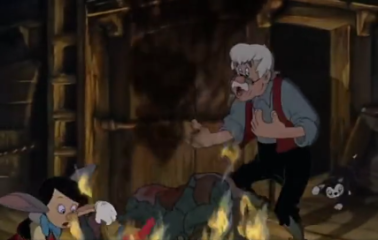 Well, Pinocchio is dead-set on getting out of Monstro’s belly, and he has an idea: make a fire to make the whale sneeze them out. And this is kind-of an interesting idea, because humans are fire users in a sense, it’s a primordial element to being. So the first thing that Pinocchio does when he is down at the deepest level of chaos, is to create a fire to rise back up. And what that symbolically means is that to produce order to get out of the deepest levels of chaos is to embody the same spirit that mastered fire. And that is exactly what he does, even though Gepetto opposes it, but they are eventually sneezed out of the whale with Jiminy Cricket and the raft Gepetto built.
Well, Pinocchio is dead-set on getting out of Monstro’s belly, and he has an idea: make a fire to make the whale sneeze them out. And this is kind-of an interesting idea, because humans are fire users in a sense, it’s a primordial element to being. So the first thing that Pinocchio does when he is down at the deepest level of chaos, is to create a fire to rise back up. And what that symbolically means is that to produce order to get out of the deepest levels of chaos is to embody the same spirit that mastered fire. And that is exactly what he does, even though Gepetto opposes it, but they are eventually sneezed out of the whale with Jiminy Cricket and the raft Gepetto built.
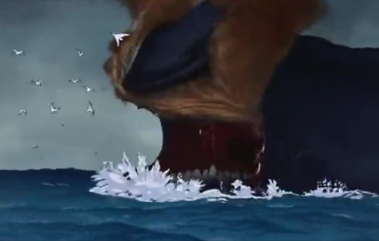 This is some nice “gates of hell” imagery right here, with the whale furiously spewing smoke and fire out from a mouth of endless darkness or void one might say. Well, the whale is incredibly mad and has the intent of killing Pinocchio and Gepetto, so they both proceed to paddle like mad to get away. You will notice at this point that the whale is not really making typical whale-like noises. The whale seems to sound very machine-like, industrial, mimicking a locomotive. You could say that the whale itself represents a combination of negative, malevolent, natural and cultural forces completely against the father and son.
This is some nice “gates of hell” imagery right here, with the whale furiously spewing smoke and fire out from a mouth of endless darkness or void one might say. Well, the whale is incredibly mad and has the intent of killing Pinocchio and Gepetto, so they both proceed to paddle like mad to get away. You will notice at this point that the whale is not really making typical whale-like noises. The whale seems to sound very machine-like, industrial, mimicking a locomotive. You could say that the whale itself represents a combination of negative, malevolent, natural and cultural forces completely against the father and son.
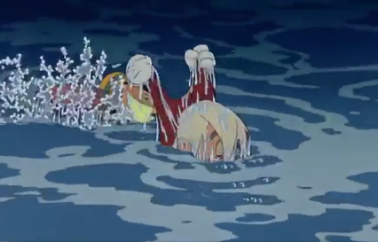 Eventually, the raft gets destroyed by the whale, and Gepetto is drowning along with Pinocchio, and he says something very important to Pinocchio as he goes down: “save yourself.” And this is Pinocchio’s last test of temptation to see if he can do the right thing this time – even without the help of Jiminy Cricket, because if you remember: Jiminy Cricket hasn’t exactly been guiding Pinocchio so far. Well, Pinocchio could easily do this and abandon his father, and this is another idea the film presents the viewers with: what exactly is your obligation, responsibility, or duty to the culture? Well, if Pinocchio had left Gepetto to die and to get to shore on his own, Pinocchio would still be the same jackass as before. And that sheds some light to the answer of this question. The answer is to save your father from the chaos depths, to integrate with that, and to save both; so that you can reincarnate the old structure into something new. Not only that, but in some sense it’s a duty to your soul as well, because your soul will be incomplete and will have learned nothing; you will still be a jackass puppet.
Eventually, the raft gets destroyed by the whale, and Gepetto is drowning along with Pinocchio, and he says something very important to Pinocchio as he goes down: “save yourself.” And this is Pinocchio’s last test of temptation to see if he can do the right thing this time – even without the help of Jiminy Cricket, because if you remember: Jiminy Cricket hasn’t exactly been guiding Pinocchio so far. Well, Pinocchio could easily do this and abandon his father, and this is another idea the film presents the viewers with: what exactly is your obligation, responsibility, or duty to the culture? Well, if Pinocchio had left Gepetto to die and to get to shore on his own, Pinocchio would still be the same jackass as before. And that sheds some light to the answer of this question. The answer is to save your father from the chaos depths, to integrate with that, and to save both; so that you can reincarnate the old structure into something new. Not only that, but in some sense it’s a duty to your soul as well, because your soul will be incomplete and will have learned nothing; you will still be a jackass puppet.
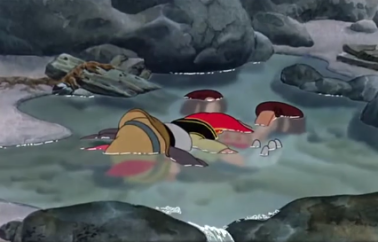 Well, that isn’t what happens: Pinocchio successfully saves Gepetto by pulling him to shore, but by doing so: Pinocchio dies. Well, and you might ask yourself why did Pinocchio have to die before he became a real boy, and the answer is back to what happened at Pleasure Island. He became a jackass who was nearly pathologized. So perhaps he had to die in order for Pinocchio to be reborn, because the experience of confronting the deepest levels of chaos was enough to destroy Pinocchio at his core, and it paves the way for something new to emerge. Basically, the old personality in a sense has to be shut off and die to give birth to the new personality. And that is exactly what happens: after Pinocchio dies, the blue fairy, which represents nature, revivifies Pinocchio into a real boy. So by not giving into the last temptation, and by saving his father from the depths of chaos, Pinocchio now transforms into a real boy. Jiminy Cricket is also given a golden badge as well, so Jiminy Cricket too has undergone a transformation: he is now oriented to the highest good or ideal.
Well, that isn’t what happens: Pinocchio successfully saves Gepetto by pulling him to shore, but by doing so: Pinocchio dies. Well, and you might ask yourself why did Pinocchio have to die before he became a real boy, and the answer is back to what happened at Pleasure Island. He became a jackass who was nearly pathologized. So perhaps he had to die in order for Pinocchio to be reborn, because the experience of confronting the deepest levels of chaos was enough to destroy Pinocchio at his core, and it paves the way for something new to emerge. Basically, the old personality in a sense has to be shut off and die to give birth to the new personality. And that is exactly what happens: after Pinocchio dies, the blue fairy, which represents nature, revivifies Pinocchio into a real boy. So by not giving into the last temptation, and by saving his father from the depths of chaos, Pinocchio now transforms into a real boy. Jiminy Cricket is also given a golden badge as well, so Jiminy Cricket too has undergone a transformation: he is now oriented to the highest good or ideal.
…And that’s the end of Pinocchio.
